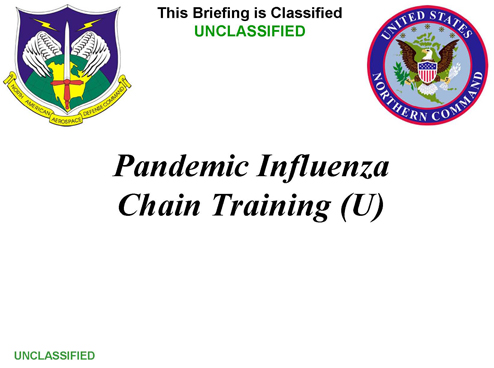PI Training Brief
- 14 pages
- March 13, 2006
•Seasonal influenza
•Influenza vaccine
•Pandemic influenza
•Protecting yourself & others
•Why are we worried?
•Preparing at home•Occurs mostly during fall/winter in U.S.
•Spread by air-borne droplets
•Viral shedding begins before symptoms start and may continue after symptoms begin to resolve
•Symptoms –fever, dry cough, aches and pains, malaise, runny nose
•Nausea, vomiting and diarrhea are extremely rare
•Symptoms may last 5-7 days in healthy individuals
•Full recovery may be prolonged
•Young, old, and those with pre-existing illness at greatest risk•Flu viruses change slightly each year
•Each year vaccines are developed to counter new strains
•Seasonal flu usually causes “mild”illness but it can be severe
•~ 36,000 extra deaths each year in the U.S. due to influenza-like illness and related complications
•Single most effective way to protect yourself
•Protects against the most common and worst strains
•Protects against severe illness
•Protects others (if you don’t get the flu, you won’t give it to anyone else)…
•Overdue for an influenza pandemic
•Previous pandemics include plague (“Black Death”) during Middle Ages and 1918 Spanish Flu
•Three conditions required for a pandemic to start:
•New virus is introduced to humans
•Virus changes to be easily passed from person to person
•People travel and move, carrying virus•Seasonal Influenza
•Occurs in cooler parts of year (winter in USA)
•Affects 10% of population
•Usually mild and not life threatening
•Very young and very old are at highest risk
•Some people have some level of pre-existing immunity
•Vaccine is available
•Antiviral drugs are available•Pandemic Influenza
•Occurs historically every 10-40 years, at any time of year
•May affect 50% of population
•Often more serious
•All age groups at risk
•People have little or no pre-existing immunity
•Vaccine unlikely to be available at first; may take six months or more to develop and distribute
•Many people affected, so antiviral drugs may be in limited supply•Wash hands frequently with soap and warm water
•Alcohol-based hand gels are not sufficient
•Use “cough etiquette”—cover mouth and nose when coughing and sneezing with tissues or sleeve
•Avoid touching your mouth, nose & eyes.
•Maintain a healthy lifestyle
•Exercise, rest, and eating balanced meals maintains body’s ability to fight infection
•Do not drink or smoke excessively
•Do not share personal items
•Stay home when sick & avoid sick people•Prepare your family as you would for natural disasters
•Plan for worst-case scenarios such as several family members becoming ill
•Discuss and make alternate plans, including:
•Plan family and child care
•Plan for pet care
•Plan for additional food and water storage
•Stock medications, diapers, formula and other crucial items
•Plan for utility outages (power, water, trash collection, etc.)
•Assemble first aid kits and medications
•Designate emergency meeting places and points of contact for family members if they become separated
•Ensure routine immunizations are current
•List and share all important contact phone numbers
•Coordinate with your service’s family support groups for help as needed

